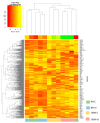Transcriptomic Profiling of Rectus Abdominis Muscle in Women with Gestational Diabetes-Induced Myopathy: Characterization of Pathophysiology and Potential Muscle Biomarkers of Pregnancy-Specific Urinary Incontinence
- PMID: 36361671
- PMCID: PMC9658972
- DOI: 10.3390/ijms232112864
Transcriptomic Profiling of Rectus Abdominis Muscle in Women with Gestational Diabetes-Induced Myopathy: Characterization of Pathophysiology and Potential Muscle Biomarkers of Pregnancy-Specific Urinary Incontinence
Abstract
Gestational diabetes mellitus (GDM) is recognized as a "window of opportunity" for the future prediction of such complications as type 2 diabetes mellitus and pelvic floor muscle disorders, including urinary incontinence and genitourinary dysfunction. Translational studies have reported that pelvic floor muscle disorders are due to a GDM-induced-myopathy (GDiM) of the pelvic floor muscle and rectus abdominis muscle (RAM). We now describe the transcriptome profiling of the RAM obtained by Cesarean section from GDM and non-GDM women with and without pregnancy-specific urinary incontinence (PSUI). We identified 650 genes in total, and the differentially expressed genes were defined by comparing three control groups to the GDM with PSUI group (GDiM). Enrichment analysis showed that GDM with PSUI was associated with decreased gene expression related to muscle structure and muscle protein synthesis, the reduced ability of muscle fibers to ameliorate muscle damage, and the altered the maintenance and generation of energy through glycogenesis. Potential genetic muscle biomarkers were validated by RT-PCR, and their relationship to the pathophysiology of the disease was verified. These findings help elucidate the molecular mechanisms of GDiM and will promote the development of innovative interventions to prevent and treat complications such as post-GDM urinary incontinence.
Keywords: gestational diabetes mellitus (GDM); gestational diabetic-induced myopathy (GDiM); pregnancy-specific urinary incontinence (PSUI); rectus abdominis muscle (RAM); transcriptomic profile.
Conflict of interest statement
The authors declare no conflict of interest. The funders had no role in the design of the study; in the collection, analyses, or interpretation of data; in the writing of the manuscript, or in the decision to publish the results.
Figures








References
-
- Rudge M.V.C., Souza F.P., Abbade J.F., Hallur R.L.S., Marcondes J.P.C., Piculo F., Marini G., Vesentini G., Thabane L., Witkin S.S. Study Protocol to Investigate Biomolecular Muscle Profile as Predictors of Long-Term Urinary Incontinence in Women with Gestational Diabetes Mellitus. BMC Pregnancy Childbirth. 2020;20:117. doi: 10.1186/s12884-020-2749-x. - DOI - PMC - PubMed
-
- Chen L., Mayo R., Chatry A., Hu G. Gestational Diabetes Mellitus: Its Epidemiology and Implication beyond Pregnancy. Curr. Epidemiol. Rep. 2016;3:1–11. doi: 10.1007/s40471-016-0063-y. - DOI
MeSH terms
Substances
Grants and funding
LinkOut - more resources
Full Text Sources
Medical

